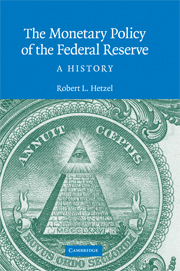Book contents
- Frontmatter
- Contents
- Figures
- Preface
- 1 The Pragmatic Evolution of the Monetary Standard
- 2 Learning and Policy Ambiguity
- 3 From Gold to Fiat Money
- 4 From World War II to the Accord
- 5 Martin and Lean-against-the-Wind
- 6 Inflation Is a Nonmonetary Phenomenon
- 7 The Start of the Great Inflation
- 8 Arthur Burns and Richard Nixon
- 9 Bretton Woods
- 10 Policy in the Ford Administration
- 11 Carter, Burns, and Miller
- 12 The Political Economy of Inflation
- 13 The Volcker Disinflation
- 14 Monetary Policy after the Disinflation
- 15 Greenspan's Move to Price Stability
- 16 International Bailouts and Moral Hazard
- 17 Monetary Policy Becomes Expansionary
- 18 Departing from the Standard Procedures
- 19 Boom and Bust: 1997 to 2001
- 20 Backing Off from Price Stability
- 21 The Volcker–Greenspan Regime
- 22 The Fed: Inflation Fighter or Inflation Creator?
- 23 The Stop–Go Laboratory
- 24 Stop–Go and Interest Rate Inertia
- 25 Monetary Nonneutrality in the Stop–Go Era
- 26 A Century of Monetary Experiments
- Appendix: Data Seen by FOMC for the Stop–Go Period Shown in Figures 24.1, 24.2, and 24.3
- Notes
- Bibliography
- Index
- Titles in the series
9 - Bretton Woods
Published online by Cambridge University Press: 26 May 2010
- Frontmatter
- Contents
- Figures
- Preface
- 1 The Pragmatic Evolution of the Monetary Standard
- 2 Learning and Policy Ambiguity
- 3 From Gold to Fiat Money
- 4 From World War II to the Accord
- 5 Martin and Lean-against-the-Wind
- 6 Inflation Is a Nonmonetary Phenomenon
- 7 The Start of the Great Inflation
- 8 Arthur Burns and Richard Nixon
- 9 Bretton Woods
- 10 Policy in the Ford Administration
- 11 Carter, Burns, and Miller
- 12 The Political Economy of Inflation
- 13 The Volcker Disinflation
- 14 Monetary Policy after the Disinflation
- 15 Greenspan's Move to Price Stability
- 16 International Bailouts and Moral Hazard
- 17 Monetary Policy Becomes Expansionary
- 18 Departing from the Standard Procedures
- 19 Boom and Bust: 1997 to 2001
- 20 Backing Off from Price Stability
- 21 The Volcker–Greenspan Regime
- 22 The Fed: Inflation Fighter or Inflation Creator?
- 23 The Stop–Go Laboratory
- 24 Stop–Go and Interest Rate Inertia
- 25 Monetary Nonneutrality in the Stop–Go Era
- 26 A Century of Monetary Experiments
- Appendix: Data Seen by FOMC for the Stop–Go Period Shown in Figures 24.1, 24.2, and 24.3
- Notes
- Bibliography
- Index
- Titles in the series
Summary
In July 1944, the West, under the leadership of the United States and Great Britain, agreed on a postwar international monetary order at Bretton Woods, New Hampshire. The IMF Articles of Agreement required member countries to fix their exchange rates by setting a par value of their currency in terms of the gold content of the dollar. Countries received quotas on which they could draw to offset temporary payments imbalances. The United States committed to pegging the dollar price of gold at $35 an ounce. Success of the new system required U.S. monetary policy to provide the nominal anchor. The United States failed to do so.
For the system to have functioned as a gold standard with gold as the nominal anchor, the United States would have had to allow its price level to vary to give the world's central banks the real amount of gold they desired to hold. Declines in the U.S. price level would have raised the purchasing power of gold and stimulated its production. A simulated gold standard would also have required that the U.S. price level adjust relative to foreign price levels to validate the equilibrium real exchange rate (given that the nominal exchange rate could not change). For the U.S. price level to have behaved in this way, the Fed would have had to allow the monetary base to decline in response to gold outflows. Only briefly in 1959 did it follow this classical gold standard rule.
- Type
- Chapter
- Information
- The Monetary Policy of the Federal ReserveA History, pp. 100 - 107Publisher: Cambridge University PressPrint publication year: 2008

